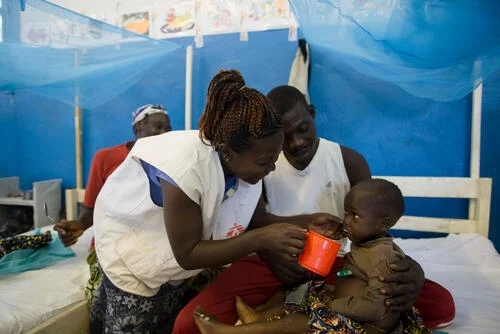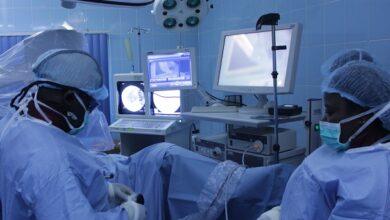
Top 15 States with High Malnutrition Rates in Nigeria
Top 15 States with High Malnutrition Rates in Nigeria – Malnutrition remains one of the biggest public health challenges in Nigeria, especially among children under the age of 5. According to the latest National Nutrition and Health Survey (NNHS) conducted in 2018, the national prevalence of malnutrition stands at 32%. This rate varies significantly across different states and geopolitical zones in the country.
In this feature article, we take a look at the top 15 states with the highest rates of malnutrition in Nigeria based on the 2018 NNHS report. Understanding the scope of malnutrition at the state level is key to designing targeted interventions and policies to combat hunger and nutrient deficiencies.
👉 Relocate to Canada Today!
Live, Study and Work in Canada. No Payment is Required! Hurry Now click here to Apply >> Immigrate to CanadaThe Top 15 states with High Malnutrition Rates in Nigeria are:
1. Borno State
With a malnutrition rate of 56%, Borno State has the highest prevalence of malnutrition in Nigeria by a wide margin. Located in the northeast, Borno has been at the epicentre of the Boko Haram insurgency that has ravaged the region for over a decade. The conflict has severely disrupted agriculture and food production, leaving millions of internally displaced persons dependent on food aid. About 65% of households in Borno are food insecure.Top 15 States with High Malnutrition Rates in Nigeria
The crisis has also severely limited access to healthcare and nutrition services. This had led to the rise of diseases like measles, diarrhoea, and cholera which exacerbate malnutrition. The interagency humanitarian response has helped mitigate the situation, but malnutrition levels remain alarming in IDP camps. Boosting local food production, improving food security, and expanding nutrition interventions will be vital for Borno’s recovery.
Read Also: 15 Best Rechargeable Lamp with Solar Charging Nigeria
2. Yobe State
Yobe is another northeastern state that has been embroiled in the Boko Haram insurgency. It has the second-highest rate of malnutrition in the country at 48.1%. Like Borno, years of conflict have deprived millions of Yobe residents of access to food, healthcare, education and income sources. About 60% of the state’s population lives below the poverty line.
The disruption of agriculture has created a massive food shortage, with only 16% of households consuming an adequate diet. Severe food insecurity has led to high malnutrition, with more than half of children under 5 being stunted or wasted. The state government and aid agencies have tried to bolster food supply by way of donations and school feeding programs. But ending malnutrition sustainably will require political stability, economic revival and enhanced social services.
3. Adamawa State
Adamawa completes the trio of northeastern states grappling with alarming malnutrition fueled by insurgency. It has the third highest rate nationwide at 47.5%. The adversity has been compounded by the huge influx of IDPs from neighbouring Borno. Currently, Adamawa hosts about 400,000 IDPs scattered across camps, villages and host communities.
Like Yobe, Adamawa also suffers from high poverty rates, low food production, and a lack of social services. Gains made in recent years are threatened by attacks from Boko Haram and bandit groups. Experts have identified strengthening community nutrition and enhancing IDP livelihoods as key steps for improving nutrition security. More also needs to be done to increase school enrollment and boost women’s education.
4. Katsina State
Outside the troubled northeast, the northwest state of Katsina has emerged as a malnutrition hotspot with a rate of 47.3%. Despite being an agrarian state, Katsina is plagued by endemic poverty, illiteracy, infrastructure gaps and banditry. These factors converge to hamper nutrition in a state where 80% of residents depend on subsistence farming.
👉 Relocate to Canada Today!
Live, Study and Work in Canada. No Payment is Required! Hurry Now click here to Apply >> Immigrate to CanadaDroughts and floods also often destroy crops. This dip in the food supply is worsened by sub-optimal breastfeeding, poor dietary diversity, and a lack of clean water and sanitation. Alleviating Katsina’s malnutrition will require climate-smart agriculture, more equitable distribution of farmland, and programs to empower women and promote family planning.
Read Also: 15 Best Nigerian Dog Breed Clubs
5. Kano State
Kano’s 46.1% malnutrition rate underscores the nutrition challenges facing Nigeria’s populous northern states. High fertility rates stretch family resources thin, impacting child nutrition. Poverty, early marriage, and lack of maternal education also play a role. Although agriculture is the mainstay of Kano’s economy, food insecurity affects over 5 million people in the state.
Changing these dynamics will require better-amplified nutrition education, poverty alleviation efforts, healthcare access, and programs to lower barriers to accessing nutritious foods. Engaging community leaders is also key to overcoming cultural practices that inhibit good nutrition.
6. Jigawa State
Jigawa is another highly agrarian northern state grappling with high malnutrition, at the rate of 46%. The nutritional plight arises from low dietary diversity, with many households unable to afford protein foods. Jigawa also frequently faces climate-induced crop failures leading to reduced harvests. Food supply is worsened by poor food storage methods.
Cultural beliefs including poor infant feeding practices also contribute. Boosting nutrition will require strategies like bio-fortification of staple crops, promoting kitchen gardens, and improving food processing and storage techniques. Livelihood diversification outside of rain-fed agriculture will also help build resilience.
7. Kebbi State
Kebbi has a malnutrition prevalence of 45.5%, again reflecting the broader pattern affecting northern Nigeria. With over 80% of the population engaged in farming, Kebbi is a major food producer. However, cyclical drought and flooding often threaten harvests in the state.
Poverty prevents farmers from investing in improved inputs, infrastructure and crop storage. These dynamics drive food insecurity for both farmers and consumers. Tackling Kebbi’s malnutrition requires smarter resource allocation to agriculture, coupled with programs to boost nutrition awareness and women’s empowerment. Improved rural infrastructure will also help farmers increase productivity.
8. Sokoto State
Sokoto is northwest Nigeria’s poorest state, with over 80% poverty rate. This entrenched deprivation, along with cultural and institutional barriers, drives Sokoto’s 45.3% malnutrition, the country’s 8th highest. Low literacy inhibits nutrition awareness while unclean water and poor sanitation drive water-borne diseases.
Although agriculture is the economic mainstay, crop yields remain low. With climate change set to increase weather extremes, chronic food shortages could worsen without action to build resilience. Concerted efforts in education, women empowerment and livelihoods diversification can help improve Sokoto’s nutrition outlook.
Read Also: 15 Best Stud Machine in Nigeria
9. Zamfara State
Zamfara’s malnutrition rate stands at 45.1%, stemming from similar dynamics as other impoverished northwestern states. Widespread banditry has also worsened food insecurity by disrupting farming activities and food transport. These shocks are set against an already vulnerable context of high poverty, social deprivation and gender inequality.Information guide Nigeria
With over 3 million people estimated to be food insecure in Zamfara state, malnutrition remains a major problem. A stronger focus on improving security, livelihoods, maternal health, and childcare practices is vital for better nutrition outcomes in the state.
10. Bauchi State
Bauchi’s malnutrition prevalence of 43.8% underlines the scale of the problem in Nigeria’s northeast region. Years of underinvestment have left health, water, sanitation and other social services inadequate. This is compounded by the Boko Haram crisis that has driven up poverty and food insecurity.
Agricultural productivity is low in Bauchi due to poor infrastructure, low mechanization and inadequate extension services. Floods and drought also harm harvests. Low income from farming limits the ability of families to access nutritious foods. Urgent strategies are needed to increase food supply, improve diet diversity, boost nutrition education and strengthen social safety nets.NYSC Portal
11. Niger State
In central Nigeria, Niger State grapples with a malnutrition rate of 43%, driven by various environmental, social and institutional factors. Unreliable rainfall patterns lead to volatile crop yields and food supply. Significant food loss also occurs due to poor harvesting techniques and storage infrastructure.
Poverty prevents families from accessing high-quality healthcare and nutritious foods. Harmful traditional practices also contribute to the problem. Strategies to boost food security through resilient agriculture are vital. Engaging communities and leveraging influential institutions like religion will aid efforts to change detrimental feeding, hygiene and food habits.Good morning My Love Message
12. Kaduna State
Kaduna has the 12th highest malnutrition rate nationally at 42.5%. Stark rural-urban and inter-communal disparities in healthcare access, education, food security and poverty levels drive this high malnutrition burden. In rural areas, low diet diversity means staple grains constitute an outsized portion of meals. Micronutrient deficiencies are common, impairing growth and immunity.
Promoting biofortified crops and nutrition education are important interventions. Peace-building and equitable development policies are also vital to improve nutrition by reducing poverty and inequality. Investments in rural water access, sanitation and health services will further help strengthen nutrition across vulnerable communities.
Read Also: Top 15 Highest Paid Movie Stars in the world
13. Enugu State
Located in Nigeria’s southeast, Enugu state has a malnutrition rate of 42.3%, among the top 15 nationwide. The problem stems from multifaceted issues including household poverty, inadequate health infrastructure, suboptimal breastfeeding practices, and frequent childhood illnesses like malaria and diarrhoea. The impacts are worsened by Nigeria’s broader challenges with food supply, climate shocks, and population pressure.
Tackling Enugu’s malnutrition requires comprehensive strategies ranging from poverty alleviation to better healthcare access. Promoting good hygiene, expanding social safety nets, boosting food security and nutrition education are also key priorities. Greater focus is needed on infants, pregnant women and mentally/physically challenged people who are most vulnerable.JAMB portal
14. Abia State
Abia, another southeastern state, has about 42% of children under 5 malnourished. Subsistence agriculture provides most households with staple carbohydrates but little protein foods. This, coupled with high knowledge gaps on nutrition, leads to protein-energy malnutrition among children. Micronutrient deficiencies are also widespread.
Beyond agriculture, major drivers include poverty, food taboos, poor child feeding practices, infections, and lack of clean drinking water. Community nutrition education and counselling will help tackle myths and norms that inhibit good diets. Access to health services and economic opportunities also need major improvements to sustainably address malnutrition.
15. Ebonyi State
Ebonyi state rounds up the top 15 states with the highest malnutrition in Nigeria, at a rate of 41.5%. It exemplifies the nutrition challenges facing the country’s southeastern region. Like Abia, Ebonyi households largely rely on starchy staple foods with minimal animal protein and fruits. This dependence on carbohydrates leads to macronutrient and micronutrient deficiencies.Romantic love message
Poverty restricts access to diverse foods and quality health services. Limited nutrition knowledge and the impact of traditions like food taboos also drive malnutrition. Multisectoral strategies are required to improve health outreach, boost nutrition education, and increase incomes and agricultural productivity. Addressing cultural and religious barriers around food will also help improve dietary diversity.
Read Also: 15 Best Lotions for all Body Types in Nigeria
Conclusion
In conclusion, malnutrition remains a public health emergency in Nigeria needing urgent action. Children under 5 are most affected, gravely impacting Nigeria’s socioeconomic future. While causes vary, the 15 states profiled consistently show factors like poverty, illiteracy, food insecurity and inadequate health access driving high malnutrition.
Comprehensive, context-specific approaches are needed to sustainably address malnutrition in these hotspots. These include boosting household incomes and food supply; improving health services, water and sanitation; tackling cultural barriers around food; and expanding nutrition education. With concerted efforts, Nigeria can curb malnutrition and unlock the full potential of its children.
Check JAMB RESULT
Check and Confirm: How much is Dollar to Naira








